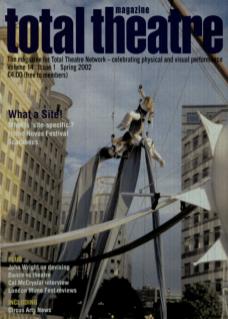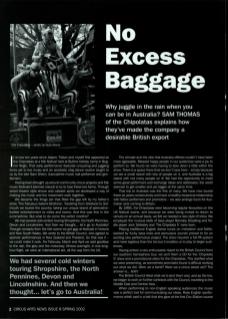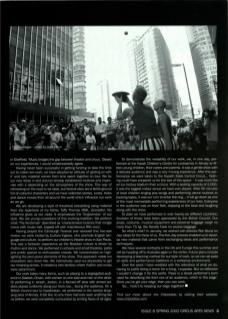It is now ten years since Jasper, Tristan and myself first appeared as the Chipolatas at a folk festival held at Butlins holiday camp in Bognor Regis. That early performance featured unicycling and juggling tricks set to live music and an acrobatic clog dance routine taught to us by the late Sam Sherry (Lancashire music hall performer and gentleman).
Having been brought up around community circus projects and folk music festivals it seemed natural to try to fuse these two forms. Through street-theatre style shows and cabaret spots we developed a way of making the music and the movement work together.
We became the fringe act that filled the gap left by my father's show The Fabulous Salami Brothers. Travelling from Shetland to Sidmouth we toured the country, taking our unique brand of adrenaline-fuelled entertainment to cities and towns. And this was fine in the summertime. But what to do come the winter months?
We had several cold winters touring Shropshire, the North Pennines, Devon and Lincolnshire. And then we thought... let's go to Australia! Through contacts from the folk scene we got gigs at festivals in Victoria and New South Wales. We wrote to the British Council, who agreed to sponsor performances in New Zealand and Thailand. So that was it – we could make it work. For February, March and April we said goodbye to the rain, the grey and the motorway. Almost overnight, in one long-haul flight, we were an international act, all the way from the UK.
The climate and the vibe that Australia offered couldn't have been more agreeable. Relaxed happy people in our audiences were a joy to perform to. We found we were having to slow down a little within the show. There is a space there that we don't have here – simply because we are a small island with lots of people on it, and Australia is a big island with not many people on it! We had the opportunity to meet some great performers and exchange ideas and addresses; the world seemed to get smaller and yet bigger at the same time.
We had several cold winters touring Shropshire, the North Pennines, Devon and Lincolnshire. And then we thought... let's go to Australia!
That trip to Australia was the first of many. We have now toured there six years consecutively and have a healthy reciprocal relationship with fellow performers and promoters – we also arrange tours for Australian acts coming to Britain.
By 1995, the Chipolatas were becoming regular favourites on the UK festival scene, and because we were being invited to return to venues on an annual basis, we felt we needed a new style of show. We employed the musical skills of bass player Barnaby Stradling and fiddle player Jock Tyldesley and 'The Chipolata 5’ were born.
Playing traditional English dance tunes on melodeon and fiddle, backed by funky bass lines and percussive sounds, proved to be an exciting new performance project. The show requires a full PA system and more logistics than the trio but it enables us to play to larger audiences.
Having written a very enthusiastic report to the British Council from our southern hemisphere tour, we sent them a CD for the Chipolata 5 show and a promotional video for the Chipolatas. This clarified what we were presenting, as sometimes promoters found it difficult working out what we did. Were we a band? Were we a circus street act? The answer is... both!
The British Council liked what we'd sent them and, as the trio, we began to work on further contracts with the Council, travelling to the Middle East and Central Asia.
When performing to non-English speaking audiences the music was a perfect tool for communicating our ideas. Rose English (performance artist) said in a talk that she gave at the first CircElation course in Sheffield: 'Music bridges the gap between theatre and circus.' Based on our experiences, I would wholeheartedly agree.
Having never been successful in getting funding to take the time out to make new work, we have adopted an attitude of ‘getting on with it' and new material comes from time spent together on tour. We try our new ideas in and around already established routines and improvise with it depending on the atmosphere of the show. This way of rehearsing on the road is not ideal, but festival sites are a fertile ground full of colourful characters and we have collected stories, tunes, tricks and dance moves from all around the world which influence our work as we go.
We are developing a style of theatrical storytelling using material from the repertoire of my father, Taffy Thomas MBE, storyteller. His influence gives us our roots. It emphasises the 'Englishness' of our style. We are young custodians of this evolving tradition. We perform what The Scotsman described as 'characterised routines that mingle circus with music hall, topped off with mischievous 90s irony’.
Having played the Edinburgh Festival and received this five-star review, we were invited by Cultura Inglesa, who promote English language and culture, to perform our children's theatre show in Sao Paulo. This was a fantastic experience as the Brazilian culture is driven by rhythm and dance. We performed in schools and small theatres, parks and public spaces to enthusiastic crowds. We concentrated on highlighting the percussive elements of the show. This approach made our characters very clown-like. We instinctively used our physicality to get our meaning across. It created a new territory where rhythm and music were paramount.
Our work takes many forms, such as playing to a segregated audience in Salalah, Oman, with women on one side and men on the other. Or performing in Jerash, Jordan, in a fenced-off area with armed soldiers placed uniformly along our front row... facing the audience. On a British Council tour to Kazakhstan, we performed in the central shopping area of Almaty. It felt like no one there had ever seen anything like us before; we were completely surrounded by smiling faces of all ages.
To demonstrate the versatility of our work, we, in one day, performed at the Kazak Children's Centre for Leukaemia in Almaty to fifteen young children, their carers and parents. It was a gentle show with a delicate audience and was a very moving experience. After this performance we were taken to the Kazakh State Central Circus... Nothing could have prepared us for the size of this space – it was more like an ice-hockey stadium than a circus. With a seating capacity of 2000, it was the biggest indoor venue we have ever played. After 45 minutes of local children singing pop songs and performing dance routines to backing tapes, it was our turn to enter the ring... It will go down as one of the most memorable performing experiences of our lives. Everyone in the audience was on their feet, clapping to the beat and laughing along with the show.
To date we have performed in over twenty-six different countries: fourteen of those have been sponsored by the British Council. Our props, costume, musical equipment and personal baggage weigh no more than 75 kg. We literally have no excess baggage.
So what's next? In January, we worked with director Ron Bunzl on new ideas for the three of us. This five-day process enabled us to develop new material that came from exchanging ideas and performance techniques.
We have several contracts in the UK and Europe this summer and will be heading off to Australia again in the winter. Future plans include developing a teaching method for our style of work, so we can we pass on skills and performance traditions in a workshop environment.
Over the years I have wrestled with the relevance of what we do, having to justify being a clown for a living, I suppose. But on reflection I wouldn't change it for the world. There is a street performer's term used for describing the front row of an audience, which is ‘the edge'. Once you've got your edge, then you can work.
So... here's to keeping our edge together!
Find out more about the Chipolatas by visiting their website: www.chipolatas.com


